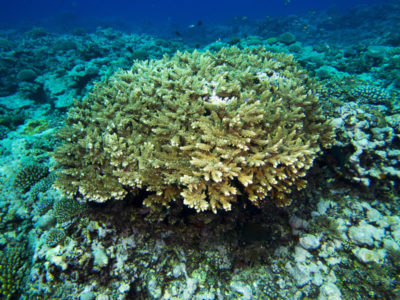Expedition Log: Cook Islands – Day 11
After a drove of crown of thorns starfish (COTS) moves through the reef, all that remains are the stark white coral skeletons. These quickly become covered in a green and brown fuzz of filamentous algae and diatoms and within a few weeks have a dull grey appearance. For a while, at least until a storm passes over the reef or the skeletons are infested with boring organisms, the reef structure remains intact and other organisms will settle on the skeletons including hard and soft corals.
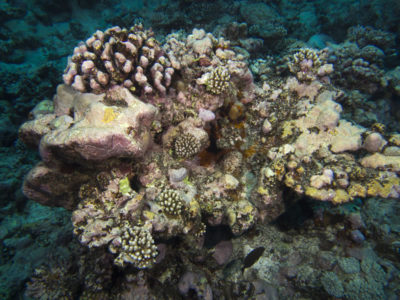
Reef recovery on the north tip of Aitutaki.
In some cases, the reef can quickly rebound. Most of the fast growing species that tend to settle quickly on old skeletons, such as the digitate, branching and table acroporids, plates of Montipora, and short-branched cauliflower coral (Pocillopora) will reappear, and coral cover can return to pre-outbreak levels within 10-15 years.
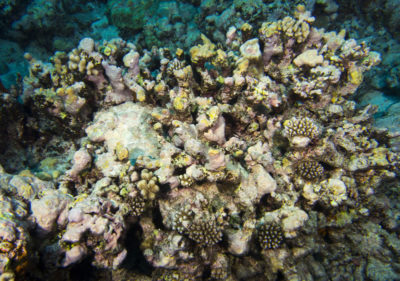
Coral head with new recruits at the north tip of Aitutaki.
This is not always the case, however. If the outbreak was particularly severe, and the starfish ate the fast growing “weedy” species as well as the older, massive frame building corals, such as Porites, it could take hundreds of years for the replacement of these large corals. Further, if other stressors are affecting the reefs –too many nutrients and sedimentation running onto the reef from shore, keystone species such as the herbivores are overfished or missing, or concurrent damage occurs from storms, bleaching events or other catastrophic events, the reef may never recover.
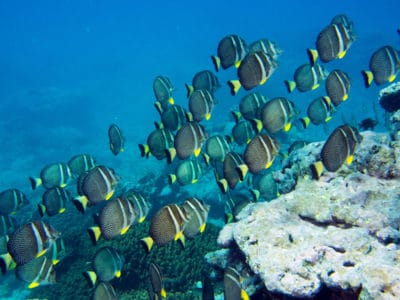
Lots of herbivores keep the reef free of algae.
In Aitutaki, we witnessed the decline and disappearance of many of the key reef building corals, and increases in the amount of fleshy seaweed within lagoonal areas. The coral skeletons remain in some locations, while sites exposed to storm waves are mostly flattened as the skeletons were removed.
Some of the fore reefs, especially the leeward western side, were carpeted with a thick layer of red crustose algae. While coral larvae are known to preferentially settle onto crustose coralline algae (CCA), this species was not what they were looking for. It formed a thick layer atop dead coral and the reef framework, creating a very smooth surface and removing much of the small cracks and crevices where the corals would normally settle. It is easily chipped off the reef as well, so any corals that settle onto it are likely to be removed as the algae is shed from the reef. Alarmingly, we also witnessed a widespread occurrence of a disease of the red algae, known as lethal orange disease.
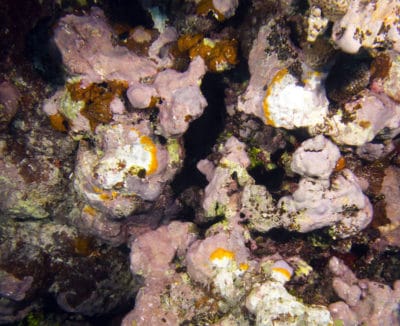
Lethal orange disease on crustose coralline algae.
There was some good news as well. After our two weeks working in Aitutaki, the starfish are now mostly gone from the reef, pockets of healthy coral remain especially on the southeastern tip, and we are beginning to see recovery in areas that were previously devastated by the starfish. There are also some corals that were completely avoided by the starfish. One of these, Porites rus, still covers large areas of the bottom in deeper water, especially on the leeward side. It forms large mounds, sheets of overlapping shingles and boulders that extend down the reef slope.

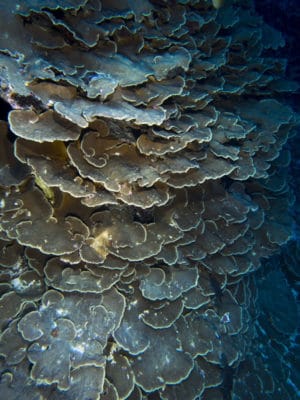
Remaining healthy area in the southeast (left).
Porites rus survives east side (right).
(click-thru on images for greater detail)
About 30% of the larger massive fame-building corals (Porites lobata) in deeper water also survived, and many more have tissue remnants that are now beginning to re-sheet over the exposed coral skeletons.
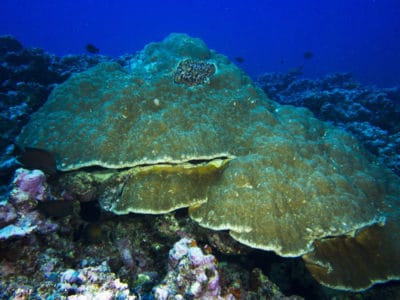
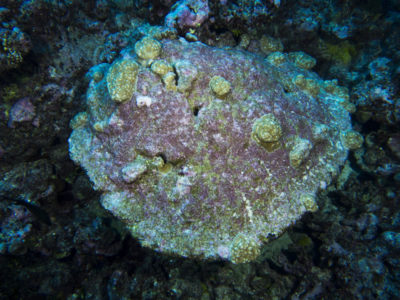
Undamaged Porites (left). / Porites tissue remnants (right).
(click-thru on images for greater detail)
A small massive star coral (Montastraea curta) is now one of the most common newly settled coral. This is the dominant species that has been able to colonize areas covered in the red crustose algae.
On the eastern side, we’ve also observed high numbers of newly settled and juvenile branching and table corals, especially various species of Acropora. Most of these are settling on old skeletons, and are growing quickly. We anticipate rapid recovery of these fast growing corals on the fore reef over the next several years, as the reef substrate is very clean with very little turf and macroalgae.
In two years we plan to revisit and reexamine the reefs of Aitutaki again. This will help us better understand how quickly a remote coral reef can rebound from the voracious predation caused by the crown-of-thorns starfish.
Photos by Andy Bruckner
